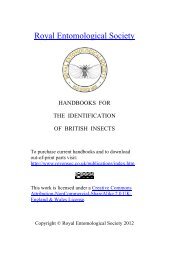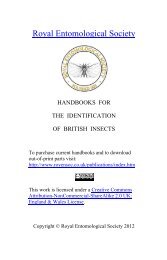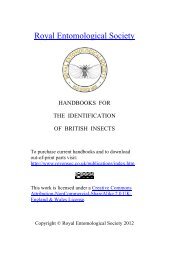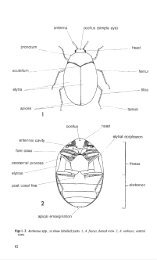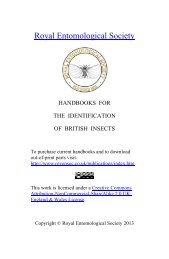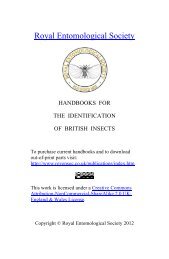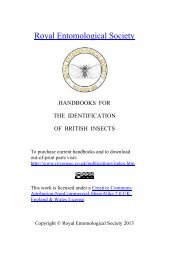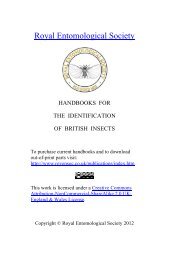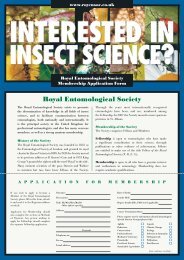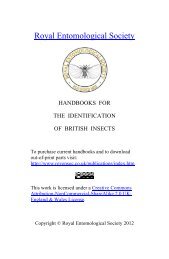Vol 10 Part 14. An introduction to the immature stages of British Flies ...
Vol 10 Part 14. An introduction to the immature stages of British Flies ...
Vol 10 Part 14. An introduction to the immature stages of British Flies ...
Create successful ePaper yourself
Turn your PDF publications into a flip-book with our unique Google optimized e-Paper software.
Trichohelea <strong>of</strong> Forcipomyia is truly aquatic). The larvae <strong>of</strong> Forcipomyia have bulbous<br />
tips <strong>to</strong> some hairs (fig. 48, detail) within which a hygroscopic substance collects moisture<br />
from <strong>the</strong> atmosphere. The water flowing down <strong>the</strong> pedicel <strong>of</strong> <strong>the</strong> hair keeps <strong>the</strong> skin<br />
moist and facilitates cuticular respiration. These beads <strong>of</strong> moisture give <strong>the</strong> larva and<br />
pupa a striking appearance when first exposed. The larvae are gregarious (20-<strong>10</strong>0 or<br />
more) in habit and pupate <strong>to</strong>ge<strong>the</strong>r (fig. 1120). They are found in dark cavities where<br />
<strong>the</strong> atmosphere approaches saturation and favours <strong>the</strong> development <strong>of</strong> moulds and<br />
o<strong>the</strong>r fungi on which <strong>the</strong> larvae feed. There are 4 instars before pupation. Habitats<br />
include under bark (F. bipunctata L., F. picea Winnertz, F. nigra Winnertz), in rotting<br />
tap-roots <strong>of</strong> <strong>An</strong>gelica etc. (F. radicicola Edwards), rotting fungi (F. ciliata Winnertz),<br />
drying horse and cow manure (F. brevipennis Macquart). F. braueri (Wasmann) and F.<br />
myrmecophila (Egger) occur in ants' nests. F. pulchrithorax Edwards lives in <strong>the</strong><br />
granular, solidifying sap in open wounds on elm, chestnut and ash trees. Saunders<br />
( 1924) gives detailed descriptions <strong>of</strong> <strong>the</strong> <strong>immature</strong> <strong>stages</strong> <strong>of</strong> several species.<br />
Larvae <strong>of</strong> Atrichopogon (fig. 49) have <strong>the</strong> body segments flattened in cross section.<br />
They are found in moist soil at <strong>the</strong> water's edge and among accumulations <strong>of</strong> floating<br />
plants.<br />
The pupae <strong>of</strong> Forcipomyia and Atrichopogon retain <strong>the</strong> larval skin over <strong>the</strong> apical<br />
half <strong>of</strong> <strong>the</strong> body (fig. 1120). Few Diptera do this (see introduc<strong>to</strong>ry section on pupae).<br />
Dasyheleinae. This subfamily has only one genus, Dasyhelea (fig. 50).<br />
Keilin ( 1921) reviews <strong>the</strong> larval habitats, including those <strong>of</strong> <strong>the</strong> following <strong>British</strong><br />
species: D. bensoni Edwards (diplosis Keiffer, among filamen<strong>to</strong>us algae in a brackish<br />
pool); D. dufouri (Laboulbene) (in thick sap in wounds on elm); D.fiavifrons (Guerin<br />
Meneville) (in sap <strong>of</strong> beech and horse-chestnut); D. versicolor (Winnertz) (in humus<br />
around roots <strong>of</strong> Spiraea ulmaria and <strong>An</strong>gelica, from scum on surface <strong>of</strong> aquarium<br />
and (as obscura Winnertz) from elm sap, hornbeam sap and a water filled hole in an<br />
oak tree). D. bilineata Goetghebuer has been reared from <strong>the</strong> axil-waters <strong>of</strong> teasels<br />
(Dipsacusfullonum L.) by Disney & Wirth (1982). I have also seen Dasyhelea larvae<br />
from water in an old frying-pan used as a bird bath. The identity <strong>of</strong> <strong>the</strong> species recorded<br />
from water-filled tree-holes by Kitching (1972) is uncertain.<br />
Cera<strong>to</strong>pogoninae. This subfamily is divided in<strong>to</strong> five tribes. The Culicoidini contains<br />
Culicoides, <strong>the</strong> only genus occurring in Britain with blood-sucking adult females<br />
(divided in<strong>to</strong> six subgenera). The larvae (fig. 52) are long, smooth, dull whitish or<br />
translucent, progress with a snake-like lashing motion and are mostly aquatic.<br />
Kettle & Lawson ( 1952) key <strong>the</strong> larvae and pupae <strong>of</strong> 28 <strong>of</strong> <strong>the</strong> <strong>British</strong> species <strong>of</strong><br />
Culicoides, distinguish some o<strong>the</strong>r genera <strong>of</strong> <strong>the</strong> subfamily, and classify <strong>the</strong> larval<br />
habitats as follows (some genera from o<strong>the</strong>r tribes are also included):<br />
I. Bogland with ground cover <strong>of</strong> <strong>the</strong> mosses Sphagnum and Polytrichum penetrated by ]uncus<br />
articulatus (s. 1.): Culicoides impunctatus Goetghebuer (dominant), C. clin<strong>to</strong>ni Boorrnan<br />
(=C. truncorum Edwards, <strong>of</strong> Kettle & Lawson, 1952), C. heliophilus Edwards, C. albicans<br />
(Winnertz), C. obsoletus (Meigen) and Cera<strong>to</strong>pogon spp.<br />
2. Freshwater marsh without Sphagnum and Polytrichum, but with meadow plants e.g.<br />
Cardamine pratensis L. and Ranunculus spp. and sometimes with abundant ]uncus spp.:<br />
Culicoides kibunensis Tokunaga (=cubit a/is Edwards) (dominant), C. pallidicornis<br />
Kieffer, C. obsoletus, C. pulicaris (L.), C. delta Edwards, C. puncta/us (Meigen), C. odibilis<br />
A us ten, Stilobezzia spp., Cera<strong>to</strong>pogon spp. and Serromyia spp.<br />
3. Areas continually under water, e.g. swamp: C. kibunensis (dominant when Carex riparia<br />
cover present), C. odibilis (dominant when Carex cover absent), C. pulicaris. C. puncta/us.<br />
C.fascipennis (Staeger) (dominant in two swamps on margins <strong>of</strong> lochs).<br />
4. On areas <strong>of</strong> bare mud: C. odibilis (dominant), C. kibunensis, C. pallidicornis, C. pu/icaris. C.<br />
stigma (Meigen) and if <strong>the</strong>re is slight organic pollution C. nebeculosus (Meigen) is<br />
dominant.<br />
42




